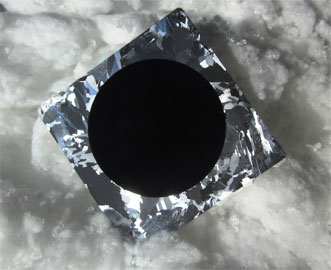With a newly certified 22.1 percent efficiency rating and wider angular acceptance than other materials, "black silicon" solar cells may now be ready for prime time.
Researchers from Aalto University in Finland and the Polytechnic University of Catalonia in Spain achieved the new record by applying a thin, passivating film of conformal alumina to nanostructured silicon via atomic layer deposition. The new cells also integrate all metal contacts on the back side of the cell.
The new efficiency record, which represents a nearly 4 percent increase over earlier black silicon solar cells, was certified by the Fraunhofer Institute for Solar Energy Systems' CalLab.

New nanostructured silicon solar cells coated with a passivating film have been certified 22.1 percent efficient. Courtesy of Aalto University.
Surface recombination has long been a problem in black silicon solar cells and has limited efficiency to less than 20 percent, the researchers said. The new cells consists of a thick, back-contacted structure known to be highly sensitive to front-surface recombination.
Certified external quantum efficiency of 96 percent at 300 nm demonstrates that the increased surface recombination problem no longer exists and that, for the first time, black silicon is not limiting the final energy conversion efficiency.
"The energy conversion efficiency is not the only parameter that we should look at," said professor Hele Savin of Aalto University, who coordinated the study. "Due to the ability of black cells to capture solar radiation from low angles, they generate more electricity already over the duration of one day as compared to the traditional cells."
"This is an advantage particularly in the north, where the sun shines from a low angle for a large part of the year," she said. "We have demonstrated that in winter Helsinki, black cells generate considerably more electricity than traditional cells, even though both cells have identical efficiency values."
In the near future, the goal of the team is to apply the technology to other cell structures – in particular, thin and multicrystalline cells.
"Our record cells were fabricated using p-type silicon, which is known to suffer from impurity-related degradation," Savin said. "There is no reason why even higher efficiencies could not be reached using n-type silicon or more advanced cell structures."
The development of the cells fabricated last year will continue in an upcoming project supported by the European Union, in which Savin and her team will develop the technology further in cooperation with industry.
"The surface area of the best cells in the study was already 9 cm2," she said. "This is a good starting point for upscaling the results to full wafers and all the way to the industrial scale."
The results were published in Nature Nanotechnology (doi: 10.1038/nnano.2015.89).
For more information, visit www.aalto.fi.